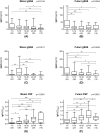IgG1 and IgG4 antibody responses to the Anopheles gambiae salivary protein gSG6 in the sympatric ethnic groups Mossi and Fulani in a malaria hyperhendemic area of Burkina Faso
- PMID: 24760038
- PMCID: PMC3997568
- DOI: 10.1371/journal.pone.0096130
IgG1 and IgG4 antibody responses to the Anopheles gambiae salivary protein gSG6 in the sympatric ethnic groups Mossi and Fulani in a malaria hyperhendemic area of Burkina Faso
Abstract
Human antibody response to the Anopheles gambiae salivary protein gSG6 has recently emerged as a potentially useful tool for malaria epidemiological studies and for the evaluation of vector control interventions. However, the current understanding of the host immune response to mosquito salivary proteins and of the possible crosstalk with early response to Plasmodium parasites is still very limited. We report here the analysis of IgG1 and IgG4 subclasses among anti-gSG6 IgG responders belonging to Mossi and Fulani from Burkina Faso, two ethnic groups which are known for their differential humoral response to parasite antigens and for their different susceptibility to malaria. The IgG1 antibody response against the gSG6 protein was comparable in the two groups. On the contrary, IgG4 titers were significantly higher in the Fulani where, in addition, anti-gSG6 IgG4 antibodies appeared in younger children and the ratio IgG4/IgG1 stayed relatively stable throughout adulthood. Both gSG6-specific IgG1 and IgG4 antibodies showed a tendency to decrease with age whereas, as expected, the IgG response to the Plasmodium circumsporozoite protein (CSP) exhibited an opposite trend in the same individuals. These observations are in line with the idea that the An. gambiae gSG6 salivary protein induces immune tolerance, especially after intense and prolonged exposure as is the case for the area under study, suggesting that gSG6 may trigger in exposed individuals a Th2-oriented immune response.
Conflict of interest statement
Figures





Similar articles
-
Differential antibody response to the Anopheles gambiae gSG6 and cE5 salivary proteins in individuals naturally exposed to bites of malaria vectors.Parasit Vectors. 2014 Nov 28;7:549. doi: 10.1186/s13071-014-0549-8. Parasit Vectors. 2014. PMID: 25428638 Free PMC article.
-
Humoral response to the Anopheles gambiae salivary protein gSG6: a serological indicator of exposure to Afrotropical malaria vectors.PLoS One. 2011 Mar 17;6(3):e17980. doi: 10.1371/journal.pone.0017980. PLoS One. 2011. PMID: 21437289 Free PMC article.
-
Wide cross-reactivity between Anopheles gambiae and Anopheles funestus SG6 salivary proteins supports exploitation of gSG6 as a marker of human exposure to major malaria vectors in tropical Africa.Malar J. 2011 Jul 27;10:206. doi: 10.1186/1475-2875-10-206. Malar J. 2011. PMID: 21794142 Free PMC article.
-
Anopheles salivary antigens as serological biomarkers of vector exposure and malaria transmission: A systematic review with multilevel modelling.Elife. 2021 Dec 23;10:e73080. doi: 10.7554/eLife.73080. Elife. 2021. PMID: 34939933 Free PMC article.
-
Human antibodies against Anopheles salivary proteins: emerging biomarkers of mosquito and malaria exposure.Trends Parasitol. 2025 May;41(5):361-373. doi: 10.1016/j.pt.2025.03.009. Epub 2025 Apr 16. Trends Parasitol. 2025. PMID: 40246632 Review.
Cited by
-
Exploring the naturally acquired response to Pvs47 gametocyte antigen.Front Immunol. 2024 Oct 10;15:1455454. doi: 10.3389/fimmu.2024.1455454. eCollection 2024. Front Immunol. 2024. PMID: 39450180 Free PMC article.
-
Differential antibody response to the Anopheles gambiae gSG6 and cE5 salivary proteins in individuals naturally exposed to bites of malaria vectors.Parasit Vectors. 2014 Nov 28;7:549. doi: 10.1186/s13071-014-0549-8. Parasit Vectors. 2014. PMID: 25428638 Free PMC article.
-
Evaluation of cutaneous immune response in a controlled human in vivo model of mosquito bites.Nat Commun. 2022 Nov 17;13(1):7036. doi: 10.1038/s41467-022-34534-9. Nat Commun. 2022. PMID: 36396947 Free PMC article. Clinical Trial.
-
Long-Lasting Permethrin-Impregnated Clothing Protects Against Mosquito Bites in Outdoor Workers.Am J Trop Med Hyg. 2015 Oct;93(4):869-74. doi: 10.4269/ajtmh.15-0130. Epub 2015 Jul 20. Am J Trop Med Hyg. 2015. PMID: 26195460 Free PMC article.
-
Human IgG responses to Anopheles gambiae immunogenic salivary proteins in urban and rural populations of Burkina Faso: biomarkers of exposure to malaria vector bites.Parasit Vectors. 2025 May 19;18(1):179. doi: 10.1186/s13071-025-06792-1. Parasit Vectors. 2025. PMID: 40390136 Free PMC article.
References
-
- Ribeiro JMC, Arcà B (2009) From Sialomes to the Sialoverse: An Insight into Salivary Potion of Blood-Feeding Insects. Advances in Insect Physiology 37: 59–118.
-
- Schwartz BS, Ribeiro JM, Goldstein MD (1990) Anti-tick antibodies: an epidemiologic tool in Lyme disease research. Am J Epidemiol 132: 58–66. - PubMed
-
- Barral A, Honda E, Caldas A, Costa J, Vinhas V, et al. (2000) Human immune response to sand fly salivary gland antigens: a useful epidemiological marker? Am J Trop Med Hyg 62: 740–745. - PubMed
-
- Nascimento RJ, Santana JM, Lozzi SP, Araujo CN, Teixeira AR (2001) Human IgG1 and IgG4: the main antibodies against Triatoma infestans (Hemiptera: Reduviidae) salivary gland proteins. Am J Trop Med Hyg 65: 219–226. - PubMed
-
- Caljon G, Van Den Abbeele J, Sternberg JM, Coosemans M, De Baetselier P, et al. (2006) Tsetse fly saliva biases the immune response to Th2 and induces anti-vector antibodies that are a useful tool for exposure assessment. Int J Parasitol 36: 1025–1035. - PubMed
Publication types
MeSH terms
Substances
LinkOut - more resources
Full Text Sources
Other Literature Sources

